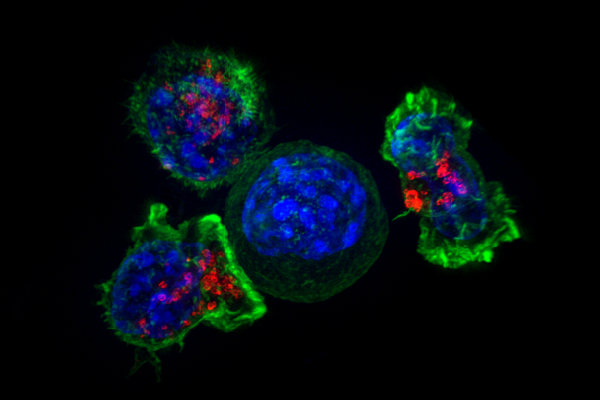Why cancer drugs can't take the pressure

A major reason why cancer drugs fail is that they cannot penetrate the high-pressure environment of solid tumors. A study published May 10th in Biophysical Journal reveals that a large, naturally occurring molecule called hyaluronic acid is primarily responsible for generating elevated gel-fluid pressures in tumors. In a mouse model of pancreatic cancer, treatment with an enzyme that breaks down hyaluronic acid normalized fluid pressure in tumors and allowed vessels to re-expand, thereby overcoming a major barrier to drug delivery.
"We show that the gel-fluid phase generates a primary mechanism of drug resistance in pancreas cancer," says senior study author Sunil Hingorani of the Fred Hutchinson Cancer Research Center. "This also means that it may be worth revisiting some of the many agents that have previously failed in pancreas cancer patients and make sure they are first getting into the tumor. Similarly, elevated pressures due to a gel-fluid phase may be present in many other solid tumor types, so it may be worth seeing to what extent drug delivery can be improved in those settings as well."
Scientists first described elevated fluid pressure in tumors more than 60 years ago. Since then, a number of studies have measured fluid pressures in a variety of tumor models using classical methods such as the wick-in-needle technique. For wick-in-needle measurements, needles containing nylon threads are filled with a solution and connected to a pressure-measuring device. However, past studies using classical techniques in tumors measured only modestly elevated fluid pressures, which could not account for widespread vascular collapse—a major barrier to drug delivery.
These conventional methods are limited because they only measure freely flowing fluid, overlooking fluid that is trapped in immobile phases. For example, a large polysaccharide called hyaluronic acid is known to imbibe a large amount of water, forming a gel-like fluid in the joints and most organs of the body. Therefore, Hingorani and his team suspected that a large immobile-fluid phase generated by hyaluronic acid could be a principal driver of high pressures in many solid tumors.
To test this idea, the researchers used an instrument called a piezoelectric pressure catheter transducer to capture both free- and immobile-fluid pressures in tumors. The researchers inserted a probe containing a pressure sensor through a needle, into tumors in a mouse model of pancreatic cancer. For comparison, the researchers also performed measurements using the classical wick-in-needle technique.
Strikingly, the measurements of fluid pressure using the piezoelectric pressure catheter transducer were much higher than those captured by the wick-in-needle technique. Moreover, elevated fluid pressures measured by the pressure catheter transducer correlated with high levels of hyaluronic acid in a variety of tumor models. "Taken together, the findings show that the hyaluronic acid-dependent immobile fluid phase plays a previously underappreciated role in driving high pressures in solid tumors," Hingorani says.
The researchers next treated a mouse model of pancreatic cancer with a modified form of an enzyme called hyaluronidase, which breaks down hyaluronic acid. This treatment eliminated the immobile fluid phase and allowed vessels that had collapsed under pressure to re-expand. Because collapsed vessels pose a major impediment to drug delivery, the findings suggest that hyaluronidase treatment holds promise for improving patient outcomes for drug-resistant cancers.
Currently, a number of randomized clinical trials are examining the safety and effectiveness of hyaluronidase combination therapy in cancer patients. Preliminary results have shown that this treatment significantly improves response rates and progression-free survival in pancreatic cancer patients. In future studies, Hingorani and his team plan to further examine the mechanisms behind high immobile fluid pressures in solid tumors. "Given the importance of immobile fluid in cancer resistance, additional insights into the underlying mechanisms will could inform the development of treatment strategies that are most likely to succeed," Hingorani says.
More information: Biophysical Journal, DuFort et al.: "Interstitial Pressure in Pancreatic Ductal Adenocarcinoma Is Dominated by a Gel-Fluid Phase" www.cell.com/biophysj/fulltext … 0006-3495(16)30172-2 , DOI: 10.1016/j.bpj.2016.03.040
Journal information: Biophysical Journal
Provided by Cell Press

















